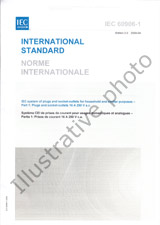We need your consent to use the individual data so that you can see information about your interests, among other things. Click "OK" to give your consent.

IEC 60756-ed.2.0
Non-broadcast video tape recorders - Time base stability
STANDARD published on 23.4.1991
The information about the standard:
Designation standards: IEC 60756-ed.2.0
Publication date standards: 23.4.1991
SKU: NS-411431
The number of pages: 21
Approximate weight : 63 g (0.14 lbs)
Country: International technical standard
Category: Technical standards IEC
The category - similar standards:
Annotation of standard text IEC 60756-ed.2.0 :
Specifies the time base errors of the monochrome as well as of the colour composite video signal reproduced from two head helical-scan domestic video recorders, recording one field on each track. This standard gives characteristics and maximum figures of the time base errors to make it possible to design the horizontal flywheel of television receivers so as to ensure stability on the screen. Specifie les erreurs dues aux bases de temps des signaux video composites monochromes ou couleur reproduits a partir des magnetoscopes grand public a defilement helicoidal a deux tetes qui enregistrent une trame sur chaque piste. Donne les valeurs caracteristiques et maximales des fluctuations de base de temps pour permettre la realisation detages de synchronisation stabilisee horizontale des recepteurs de television, assurant une stabilite acceptable de limage.
Similar standards:
26.2.2004
28.10.2005
5.6.2007
14.6.2007
6.6.2007
30.7.2009
We recommend:
Technical standards updating
Do you want to make sure you use only the valid technical standards?
We can offer you a solution which will provide you a monthly overview concerning the updating of standards which you use.
Would you like to know more? Look at this page.



 Cookies
Cookies
